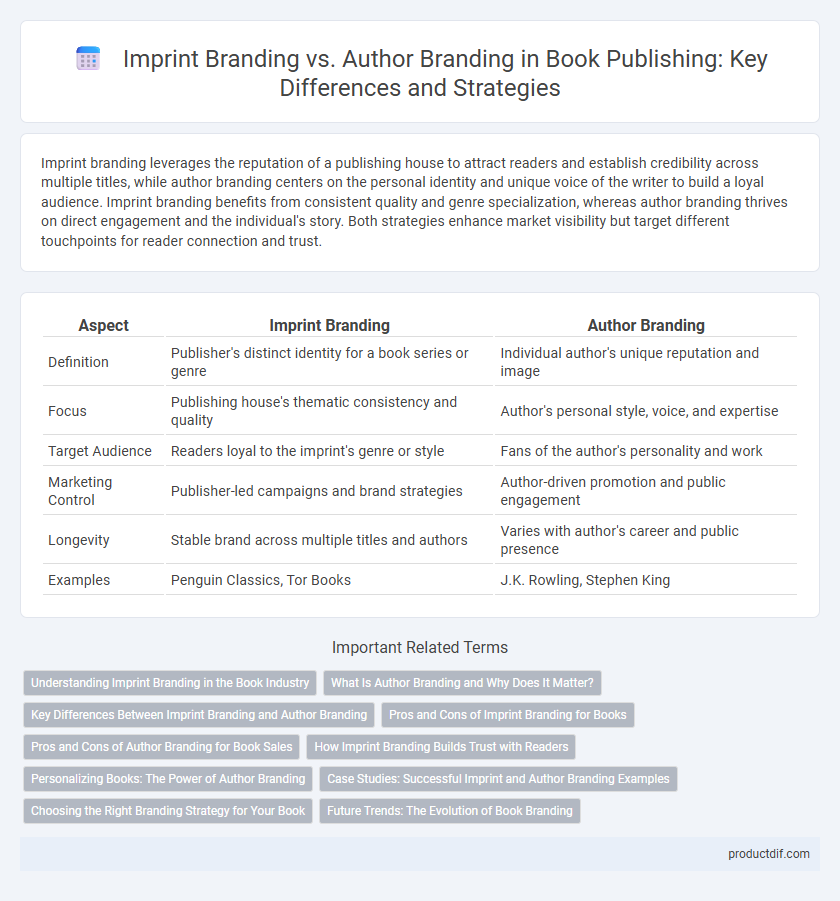Imprint branding leverages the reputation of a publishing house to attract readers and establish credibility across multiple titles, while author branding centers on the personal identity and unique voice of the writer to build a loyal audience. Imprint branding benefits from consistent quality and genre specialization, whereas author branding thrives on direct engagement and the individual's story. Both strategies enhance market visibility but target different touchpoints for reader connection and trust.
Table of Comparison
| Aspect | Imprint Branding | Author Branding |
|---|---|---|
| Definition | Publisher's distinct identity for a book series or genre | Individual author's unique reputation and image |
| Focus | Publishing house's thematic consistency and quality | Author's personal style, voice, and expertise |
| Target Audience | Readers loyal to the imprint's genre or style | Fans of the author's personality and work |
| Marketing Control | Publisher-led campaigns and brand strategies | Author-driven promotion and public engagement |
| Longevity | Stable brand across multiple titles and authors | Varies with author's career and public presence |
| Examples | Penguin Classics, Tor Books | J.K. Rowling, Stephen King |
Understanding Imprint Branding in the Book Industry
Imprint branding in the book industry refers to the strategic use of a publisher's distinct brand identity to target specific markets, genres, or reader demographics, enhancing recognition and trust. Unlike author branding, which centers on promoting an individual author's persona and body of work, imprint branding builds a cohesive image around a curated selection of titles, often under a specialized editorial vision. This approach allows publishers to position their imprints as authoritative sources within niche genres, driving sales through consistent quality and thematic focus.
What Is Author Branding and Why Does It Matter?
Author branding involves creating a distinct identity that reflects the author's voice, style, and values, helping readers connect on a personal level. It establishes credibility and trust, making it easier to build a loyal audience and increase book sales. In contrast to imprint branding, which centers on a publishing house's reputation, author branding emphasizes the unique presence and marketability of the individual writer.
Key Differences Between Imprint Branding and Author Branding
Imprint branding emphasizes the publisher's identity, creating a consistent image across multiple authors and book genres, which strengthens overall market recognition and customer trust. Author branding centers on the individual writer's unique voice, style, and reputation, fostering a dedicated reader base directly connected to the author's personal narrative and expertise. Key differences include scope--imprint branding targets broader market segments while author branding deepens emotional engagement with a specific author--and control, as publishers manage imprint branding whereas authors primarily drive their own branding efforts.
Pros and Cons of Imprint Branding for Books
Imprint branding allows publishers to build a distinct identity that can attract specific genres or markets, enhancing recognition and trust among targeted readers. It consolidates marketing efforts under a unified label, which can reduce promotional costs and foster brand loyalty over time. However, imprint branding may overshadow individual authors, limiting their personal visibility and potentially restricting their creative freedom if they must align with the imprint's established style or audience expectations.
Pros and Cons of Author Branding for Book Sales
Author branding enhances book sales by creating a personal connection with readers, fostering loyalty and repeat purchases. However, relying heavily on author branding risks overshadowing the book's content, limiting appeal if the author's popularity declines. Building a strong author brand requires consistent engagement on social media and marketing efforts, which can be time-consuming and divert focus from writing.
How Imprint Branding Builds Trust with Readers
Imprint branding establishes a consistent visual and thematic identity that signals reliability and quality to readers, fostering trust through recognizable design elements and genre-specific marketing. By aligning multiple authors under a reputable imprint, publishers create an ecosystem where readers associate the brand with positive reading experiences and editorial standards. This collective credibility often leads readers to prefer books from trusted imprints, enhancing long-term loyalty beyond individual author recognition.
Personalizing Books: The Power of Author Branding
Author branding personalizes books by creating a distinct and consistent identity that connects readers to the author's unique voice and values, enhancing emotional engagement. Unlike imprint branding, which promotes a publishing house's reputation, author branding builds loyalty through direct relationships with readers, fostering trust and recognition. Strong author branding increases book visibility and marketability by leveraging personal stories, social media presence, and author platforms to differentiate works in a crowded literary landscape.
Case Studies: Successful Imprint and Author Branding Examples
Case studies reveal that imprint branding leverages the publisher's reputation to build trust and attract a loyal audience, as seen with Penguin Classics and its consistent quality and curated selections. Author branding focuses on creating a distinctive persona and voice, exemplified by J.K. Rowling, whose name alone guarantees high sales and reader loyalty across genres. Successful strategies often integrate both, using the imprint's credibility alongside the author's unique story to maximize market impact.
Choosing the Right Branding Strategy for Your Book
Selecting the right branding strategy for your book depends on your marketing goals and target audience. Imprint branding leverages the prestige and recognition of an established publishing house, enhancing credibility, while author branding centers on building a personal connection and loyal readership through the author's unique identity and voice. Evaluating factors such as long-term career plans, genre, and promotional resources is crucial to determine whether imprint branding or author branding will maximize your book's visibility and sales potential.
Future Trends: The Evolution of Book Branding
Imprint branding and author branding are converging as publishers leverage digital platforms to create personalized reader experiences, enhancing both discoverability and loyalty. Advances in AI-driven marketing and data analytics enable tailored promotional strategies that highlight unique author voices alongside established imprints, driving engagement through multi-channel outreach. Emerging trends emphasize hybrid models where imprint reputations support author identities, fostering dynamic ecosystems that adapt to evolving consumer preferences in the book industry.
Imprint Branding vs Author Branding Infographic

 productdif.com
productdif.com